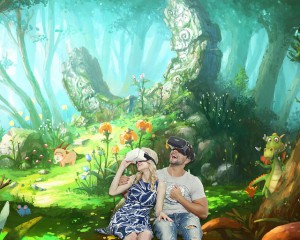 Augmented reality (AR) and virtual reality (VR) are potentially disruptive technologies. They will change how we are entertained, learn, communicate, socialize, and generally experience the world.
Augmented reality (AR) and virtual reality (VR) are potentially disruptive technologies. They will change how we are entertained, learn, communicate, socialize, and generally experience the world.
New technologies usually follow a hype cycle as shown here:
As you can see (if you click on the image to expand), both AR and VR are currently at a low point on the curve. This is because the hype has created higher public expectations for the product than the industry can deliver. But let’s assume for the moment that AR and VR truly live up to their potential. Will they be readily adopted in schools, colleges and universities to teach science? I hope so. The possibilities are exciting. There are many hurdles (school admin and teacher engagement, cost and availability of equipment) but as with most technological innovation, adoption usually follows if given enough time.
But there are two aspects of using this tech as an educational vehicle for science that merit discussion. First, if these artificial worlds become as addictive as have our mobile devices, will people not crave the virtual environment to the exclusion of real-world learning? Personally, as a biologist, my hope is that these new tools for scientific discovery by the public will ultimately inspire people to take a real-world walk through a botanic garden or a stroll through the woods, or even consider biology as a career. The tools will hopefully augment, not detract, from real-world science appreciation and experiences.
Second, as use of the tech becomes commonplace, will students eventually get bored? “Think I’ll skip biology today… we’re just going inside another cell again”. I think the developers creating the apps for VR and AR science education will be the people who continue to get the most excited… after all, we are the ones who must research these worlds, intimately understand and appreciate the science, and then present it in a graphically-stunning manner, as a game or otherwise. (A riveting soundtrack doesn’t hurt either.) Maybe one way to maintain engagement would be to come up with ways for students to create their own worlds. They do the research, put it all together, and then share with the class or on social networks. I see a use for machine learning algorithms here. Intelligent apps that facilitate the player (student) becoming the creator.
What do you think?


 Science does not approve of the practice of attributing human characteristics to non-humans. To say that a bird is ‘happy’ to be flying about on a sunny day is not permitted. But if the cause is to educate, is it permissible to anthropomorphise? To improve engagement with the public or to get a point across? I’ve sometimes fantasized about what it might be like to be a plant. Wouldn’t it be wonderful to craft a video game about plants with feelings? Or to actually be a plant? Anger that your leaves are infested with mildew? Relief that the rain has finally arrived after months of drought? Or let’s take the point of view of a molecule of water, as it journeys through its water cycle. We could imagine all kinds of sociological undertones as a water molecule interacts with all those other water molecules struggling to evaporate (me first, me first). The point is to use this tool to get people thinking about, and appreciating, science. With so much aversion to science these days, I think it’s ok, and perhaps necessary, to bend the rules. If people are to embrace all the wondrous detail of the natural world, we need them to identify with that world. And I think the plants would agree.
Science does not approve of the practice of attributing human characteristics to non-humans. To say that a bird is ‘happy’ to be flying about on a sunny day is not permitted. But if the cause is to educate, is it permissible to anthropomorphise? To improve engagement with the public or to get a point across? I’ve sometimes fantasized about what it might be like to be a plant. Wouldn’t it be wonderful to craft a video game about plants with feelings? Or to actually be a plant? Anger that your leaves are infested with mildew? Relief that the rain has finally arrived after months of drought? Or let’s take the point of view of a molecule of water, as it journeys through its water cycle. We could imagine all kinds of sociological undertones as a water molecule interacts with all those other water molecules struggling to evaporate (me first, me first). The point is to use this tool to get people thinking about, and appreciating, science. With so much aversion to science these days, I think it’s ok, and perhaps necessary, to bend the rules. If people are to embrace all the wondrous detail of the natural world, we need them to identify with that world. And I think the plants would agree.